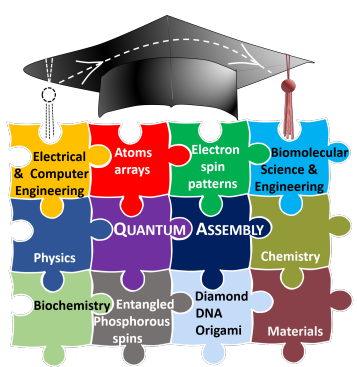Integrative Training in Quantum Assembly and Technology (InTriQATe) is an NRT program relevant to the Quantum Leap and Quantum Information Science and Engineering focus areas. This program will support and inspire the next generation of quantum scientists by providing innovative opportunities for training and professional development in an interdisciplinary collaborative context and attracting students from a variety of departments and backgrounds that may not have considered themselves as future players in quantum science and technology.
The aim of this program is to build innovative training structures that recruit and prepare students for leadership in a diverse quantum workforce. Five goals comprise this aim:
- Recruit students from diverse backgrounds to quantum science and technology research.
- Build an interdisciplinary and inclusive campus-wide quantum science community.
- Retain and sustain a healthy diverse national “pipeline” into quantum careers.
- Broaden the base of quantum science and nucleate new directions of convergence research.
- Strengthen engagement with the public and with social/ethical impacts of quantum science.

Figure 1: Quantum assembly and technology and assembly of departments.
Our approach to achieving this ambitious slate of goals is laid out in Figure 2. Innovative training activities will build a specific set of skills, which in turn will drive a range of desired outcomes. Being inquisitive about and appreciative of other disciplines and being able to effectively communicate with people from different backgrounds are key skills for future leaders. The segmentation of most universities into departments is critically limiting the development of the full potential of graduate students especially in the increasingly interdisciplinary area of quantum science. Hence, one of the first specific goals of this NRT is to recruit a new population of students who might or might not think of themselves as future quantum scientists or engineers. Active recruitment of new talent will be supported after matriculation by a robust and individualized mentorship program and new events such as the “Exploring Quantum Assembly @ Lunch” (EQuAL) seminar series. In this series, Quantum Assembly encompasses quantum phenomena in systems such as complex molecules, optical lattices, solid-state heterostructures, DNA, and even living organisms, connecting departments including Electrical and Computer Engineering, Physics, Molecular Biology, Chemistry, and Materials.

Figure 2: Structure of the InTriQATe NRT program. Innovative activities build skills, which drive outcomes.
Programmatic imperative
The “Quantum Leap” requires an appropriately trained workforce at the PhD level. Currently, this workforce comprises students with inhomogeneous training in unconnected departments; no one discipline fully prepares students for quantum science careers. Social, national, and industrial pressures demand a quantum workforce with a diverse skill set and students in diverse areas are hungry for opportunities to broaden their engagement with the fast-growing field of quantum science and technology. Future discovery and development will be driven by the emerging generation of quantum scientists entering training programs now: this makes the development of truly interdisciplinary training programs in quantum science an urgent national priority.
Scientific imperative
Quantum science is moving into a new era. While groundbreaking demonstrations of quantum phenomena ignited the second quantum revolution, to realize its promise the focus of the field must advance to higher-order concerns: assembling, scaling, and integrating. This requires a natively interdisciplinary approach which is currently not a feature of quantum science training programs. Our traineeship program is focused around the central theme of quantum assembly: the integration of disparate qubits to achieve new functionalities. In a variety of technical contexts both top-down and bottom-up quantum assemblies exhibit quantum phenomena such as quasi-particles, decoherence-free subspaces, super radiance, and phase transitions; such assemblies undergird a variety of next-generation quantum technologies. The proposed research falls naturally into three complementary focus areas: bio-templated complex quantum assembly, quantum metamaterials, and patterned atom arrays.
Institutional context
Due to a unique combination of personnel, capabilities, partnerships, and widespread strength in a field of research at a technological inflection point, UC Santa Barbara is ideally positioned to revolutionize interdisciplinary training practices in quantum science and technology. Unique campus strengths enabling quantum assembly include strong engagement with lead industrial players in quantum technology including Google and Microsoft; research and academic connections with other minority-serving institutions and HBCUs; a close engineering-physics collaboration in quantum research; world-class technical facilities; and intense student interest in quantum science. The new training capabilities implemented in the proposed InTriQATe program complement existing activities on campus. For example, UCSB was recently granted the status of Partnership Institution in the American Physical Society (APS)’s Bridge Program, as part of the Physics department’s comprehensive plan for recruitment and advising of under-represented students in its graduate program. Dissemination of best practices in professional development, mentor training, and outreach will be coordinated with UCSB’s Center for Science & Engineering Partnerships (CSEP). The NRT’s scientific theme of quantum assembly and control is complementary to the materials-focused emphasis of the NSF Quantum Foundry, and we anticipate offering access to NRT-hosted training resources to Foundry participants to advance shared goals.
Outcomes
The main outcome of the proposed program is a sustainable thriving interdisciplinary quantum science community that is highly creative, original, agile, pushing the frontiers of quantum technology, and welcoming to everyone interested in quantum science. The training program aims at generating new ideas for quantum assembly, and testing and exploring these new ideas by combining knowledge and state-of-the-art technologies across many disciplines. Our NRT trainees will work in creative interdisciplinary research teams, with the aim of generating and investigating new ideas and concepts in many-element quantum science. Finally, they will gain direct experience communicating quantum science and technology to the public.